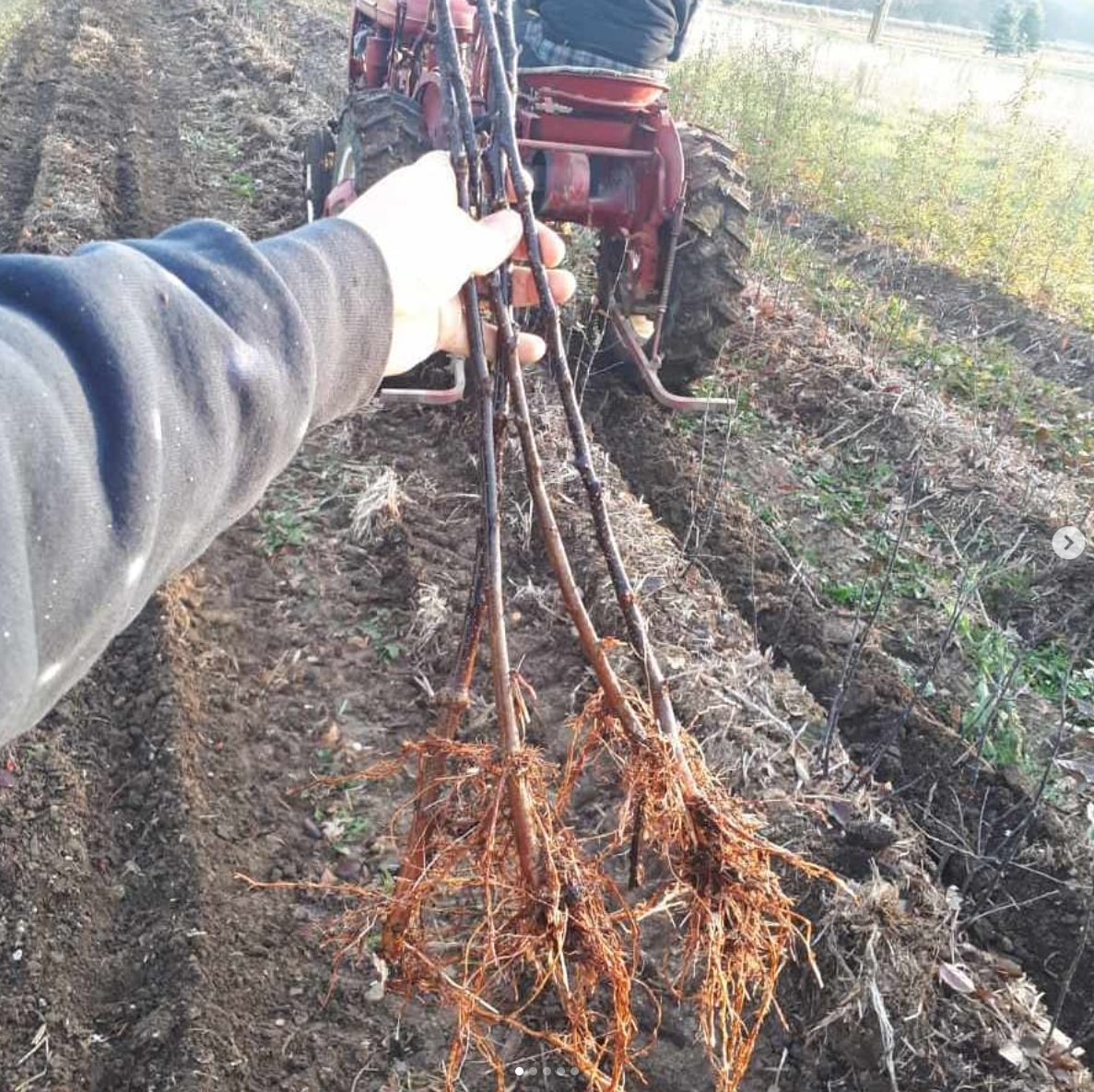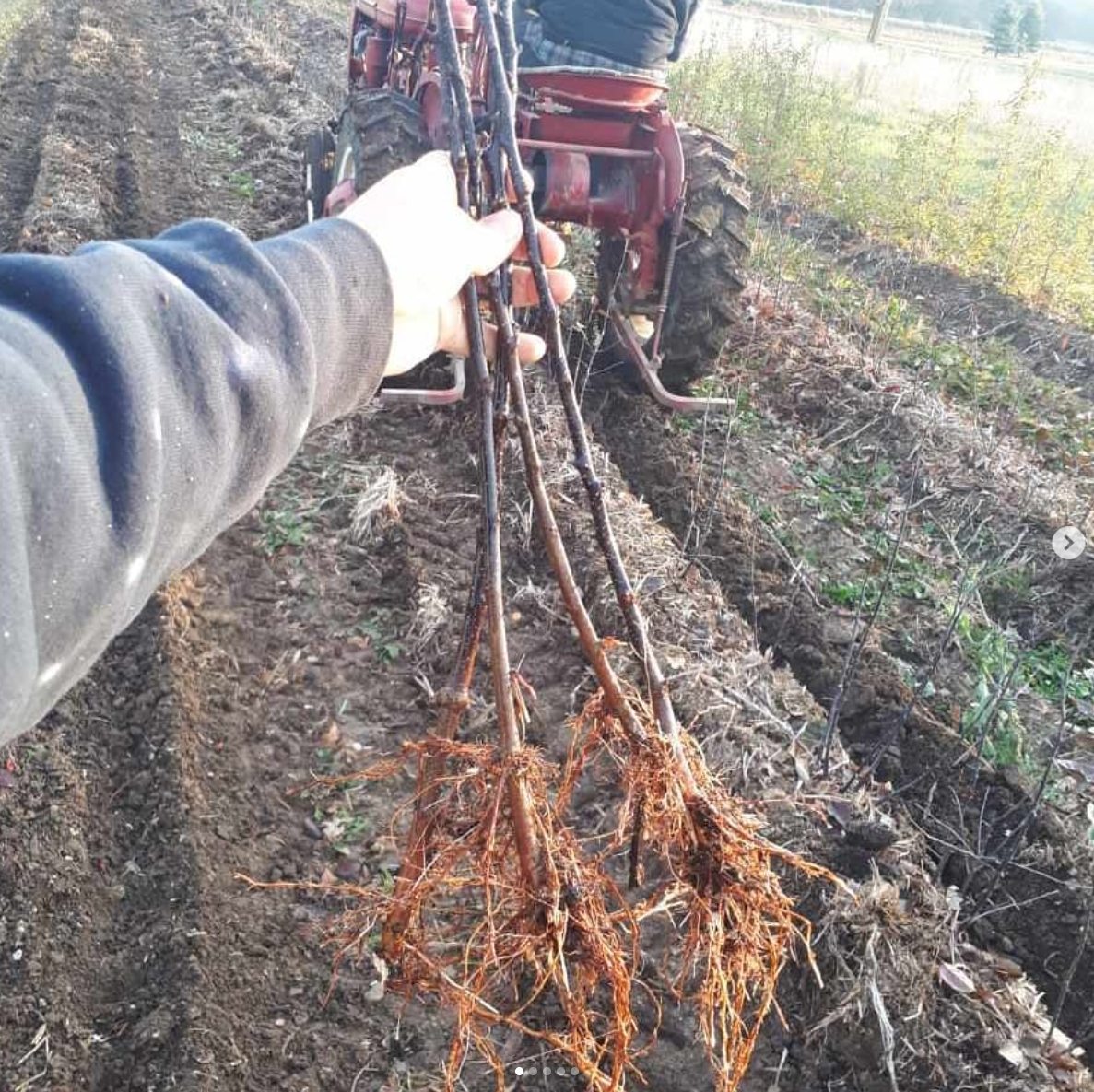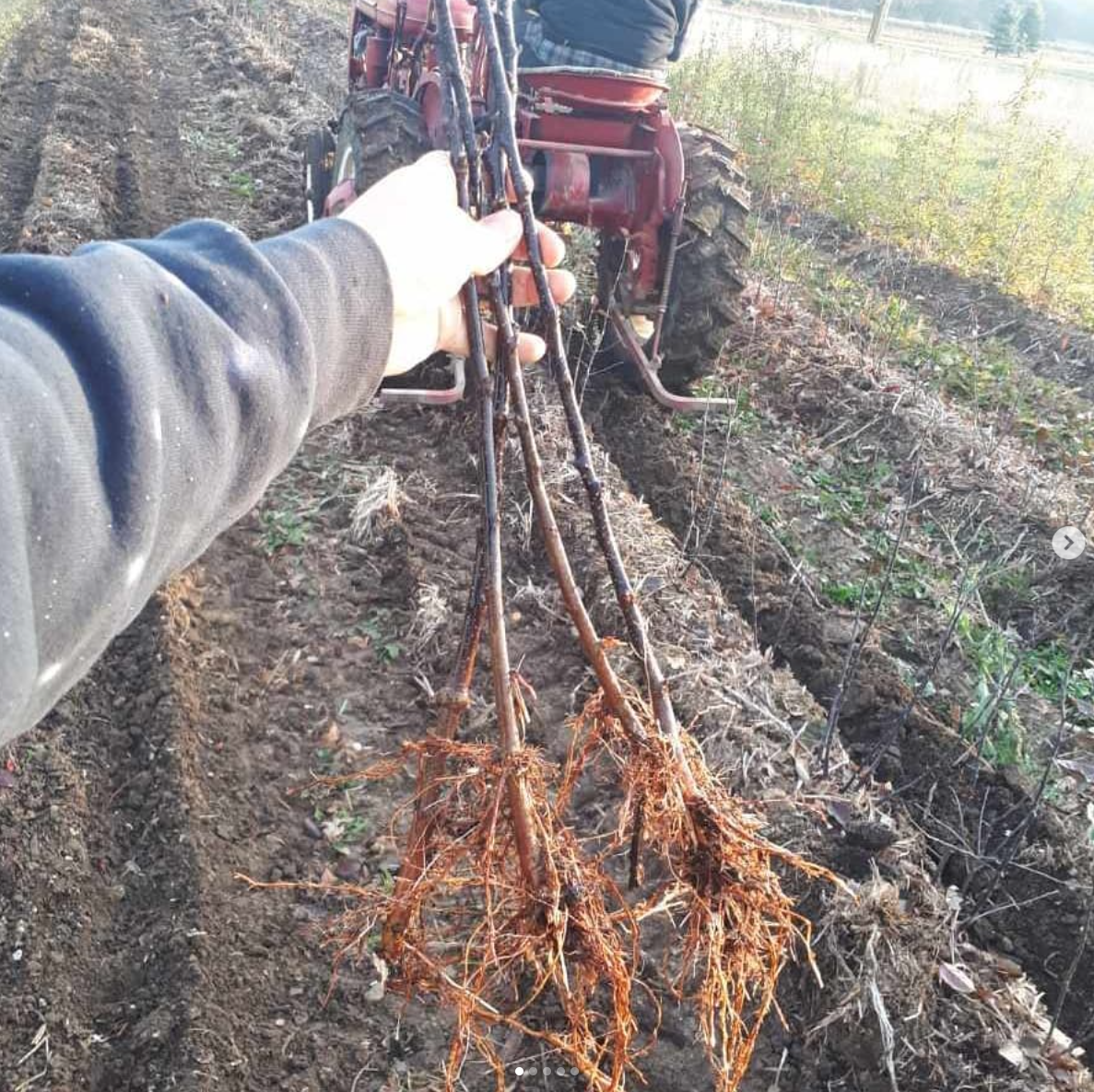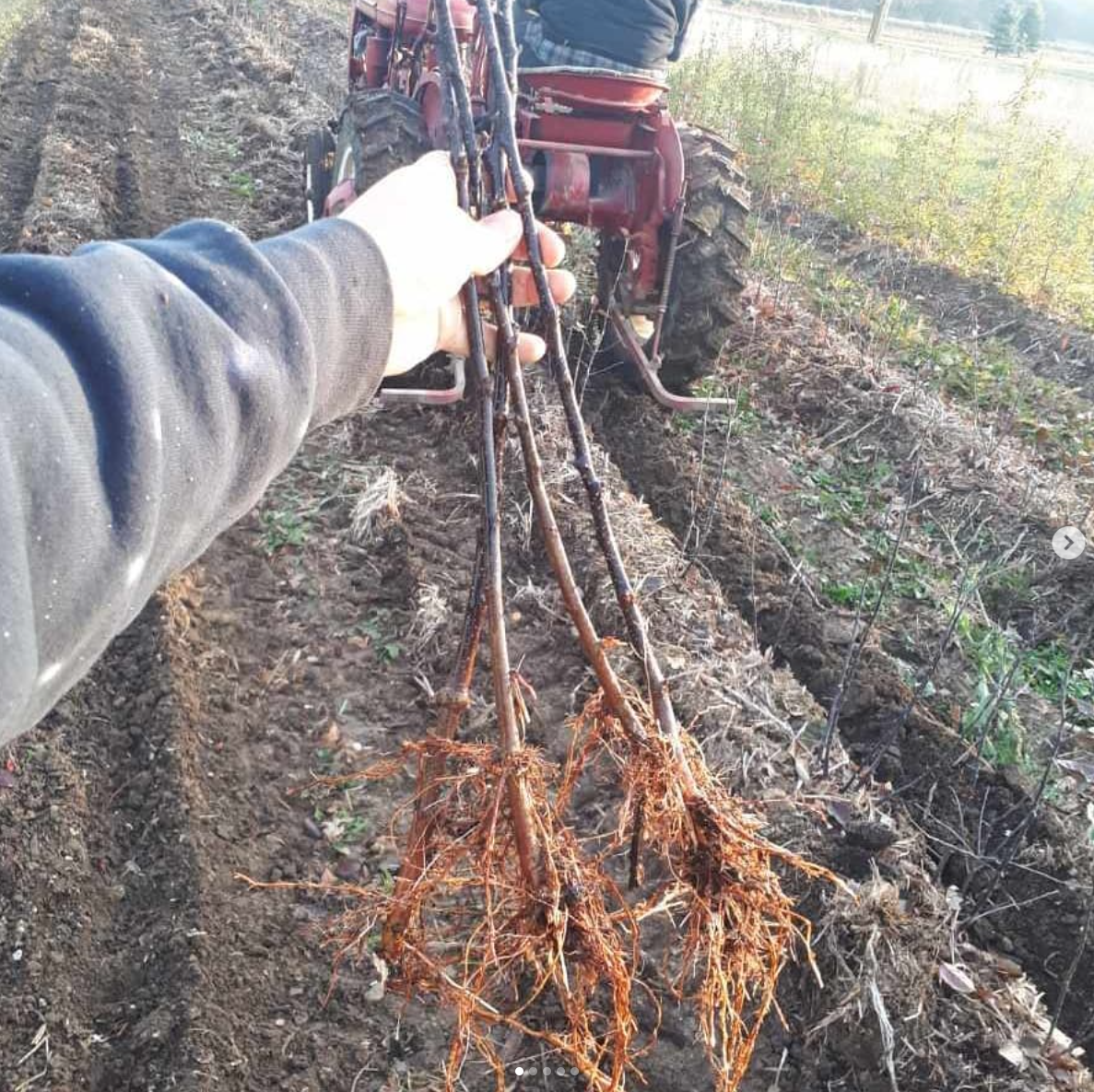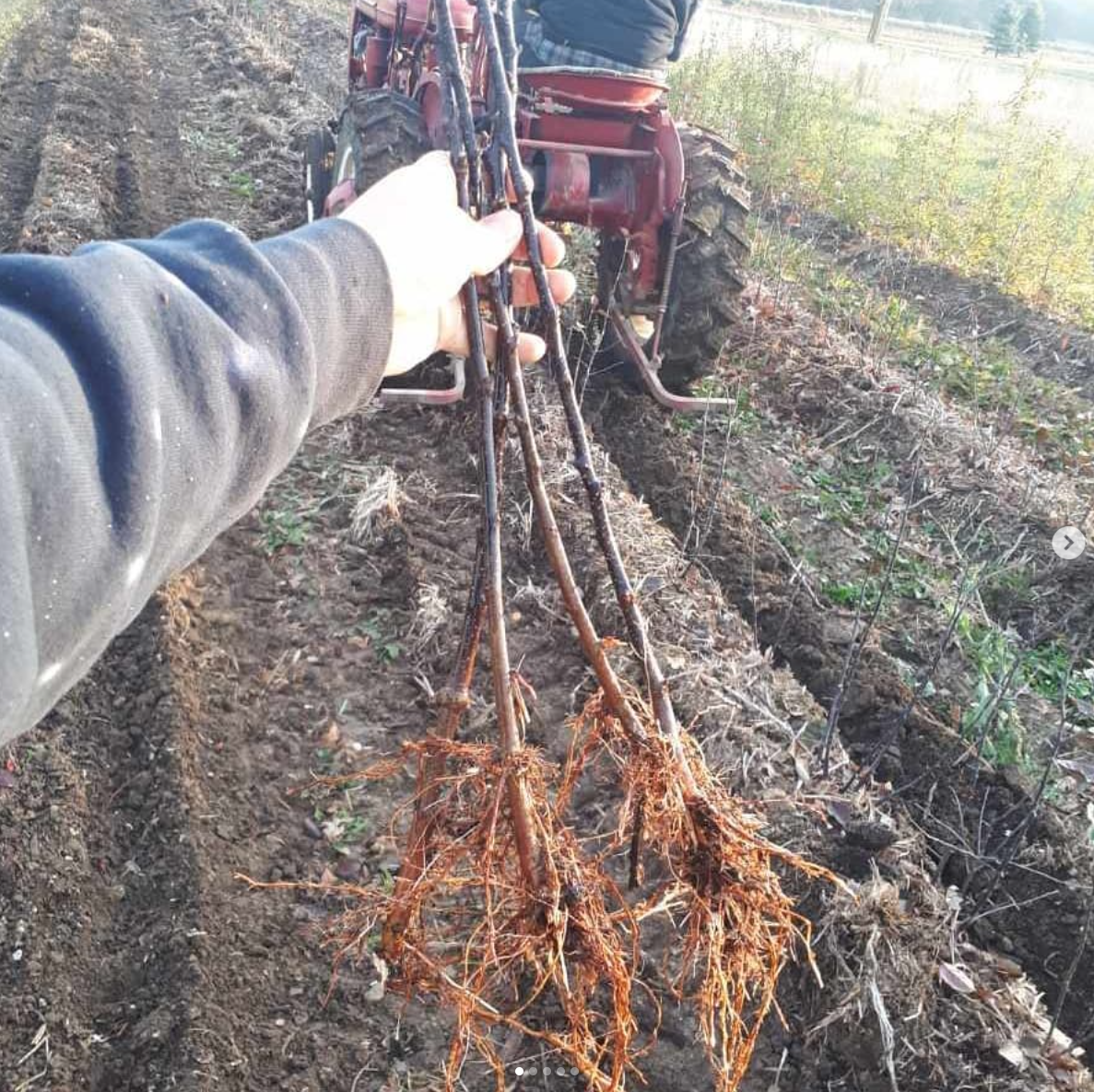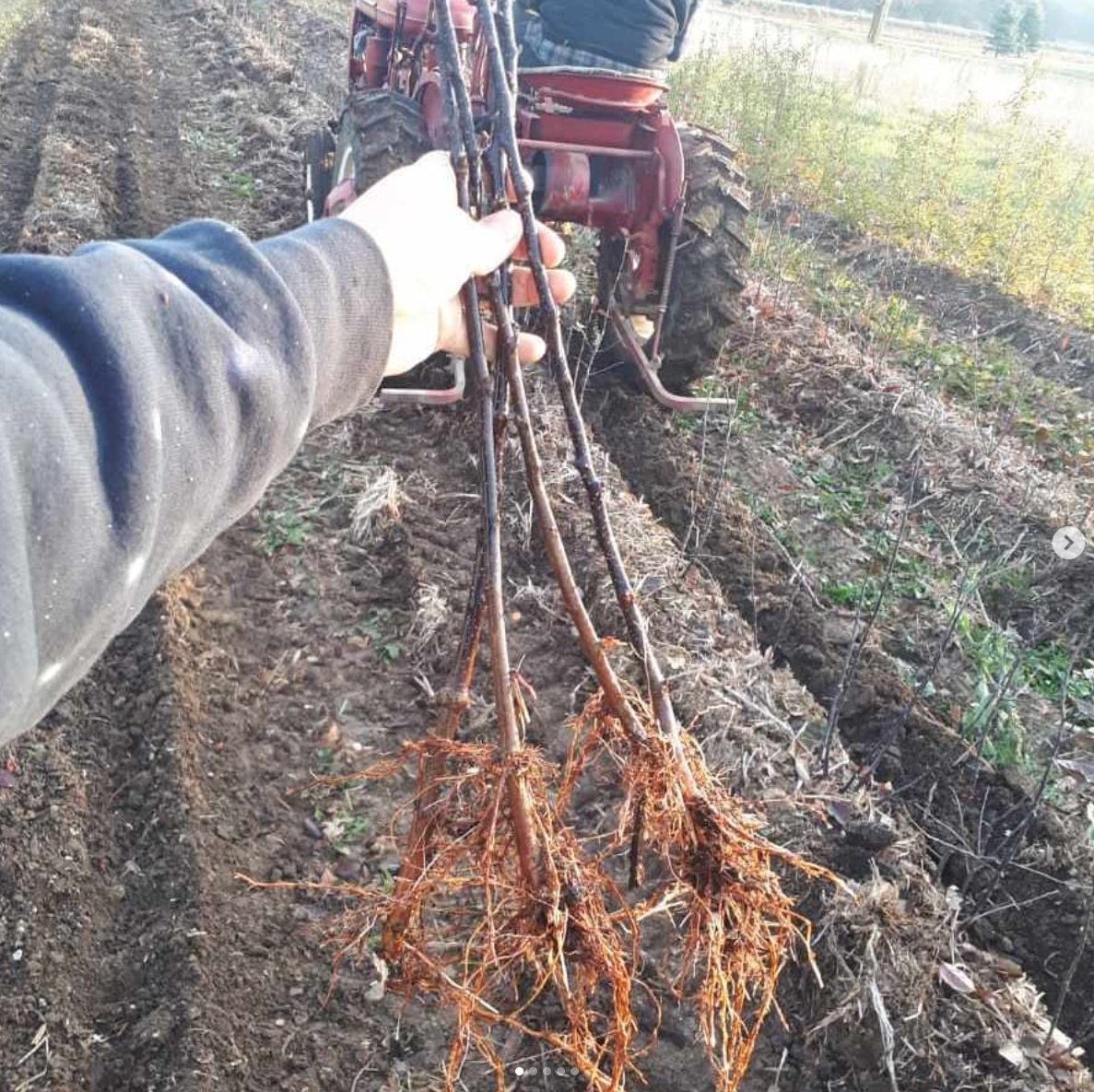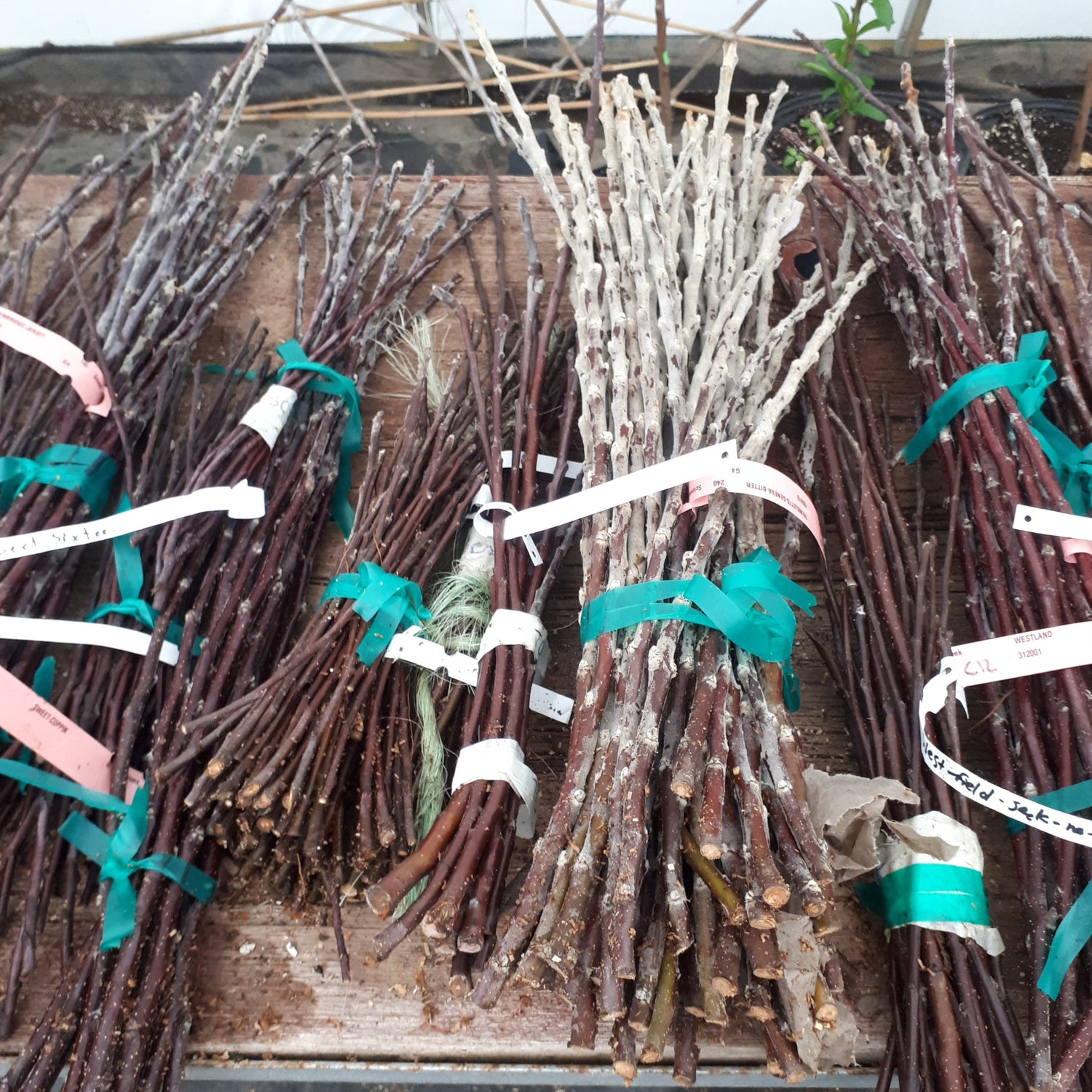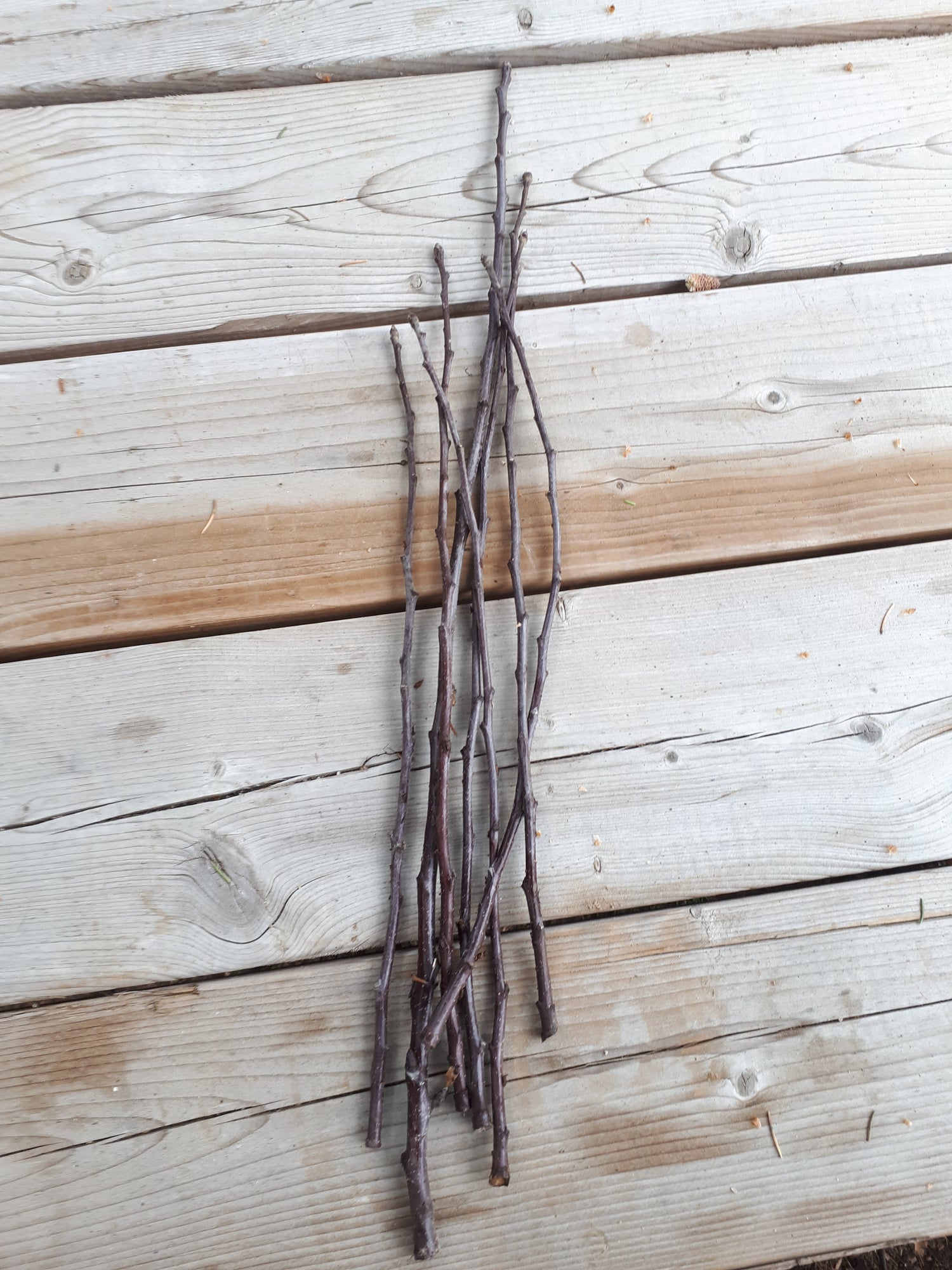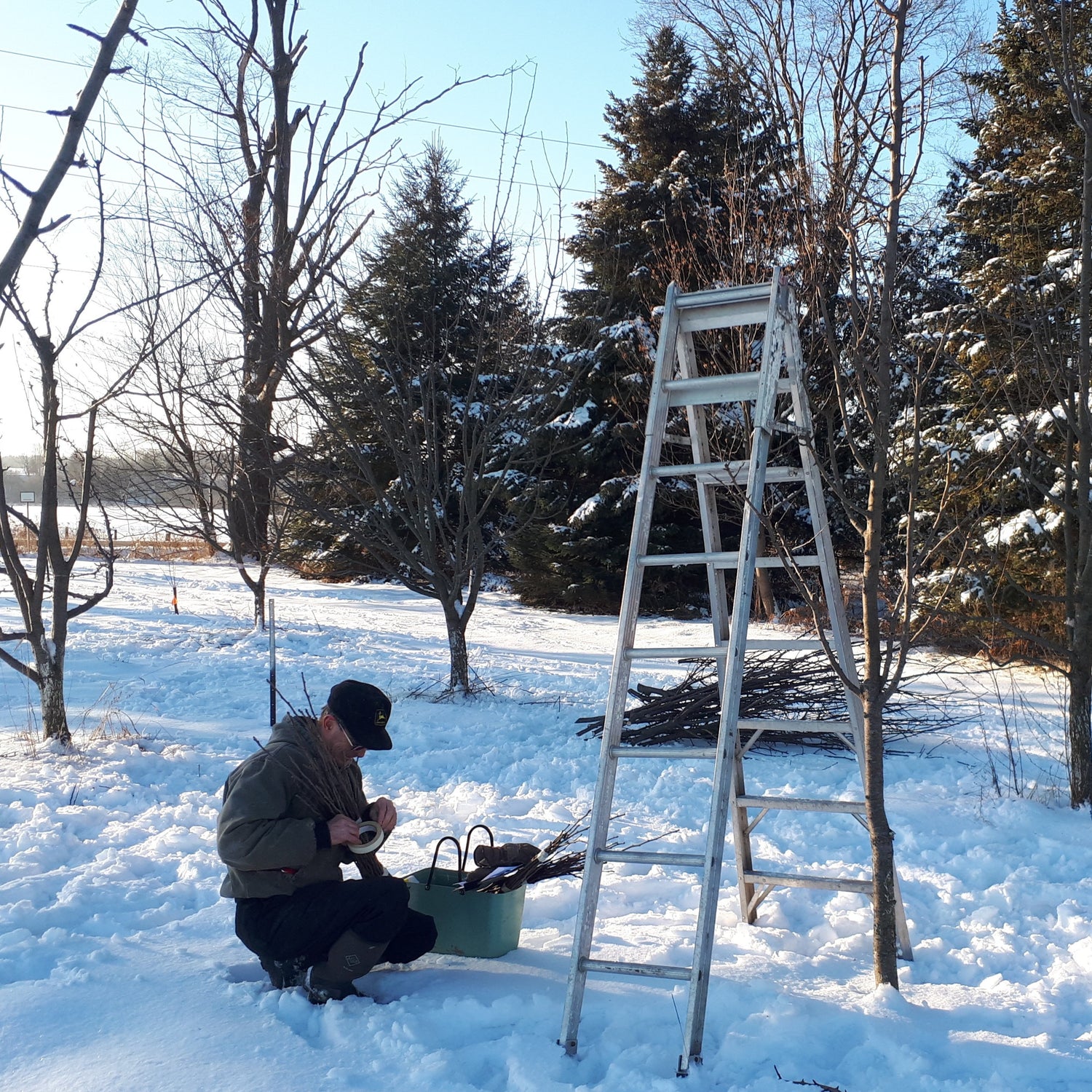Rootstock & Scionwood
Every year we get tons of requests for rootstock and scionwood. While our main business is in the finished product (grafted fruit trees), we also like to support those wishing to learn the grafting process for themselves. We can attest that it is a very enjoyable (and rather addictive) pastime!
Rootstock - We are accepting requests for Spring 2026 rootstock orders; please contact us directly if you are interested in being added to our waitlist.
Scionwood - We are accepting requests for Spring 2026 scionwood orders; please contact us directly if you are interested in being added to our waitlist.
For those new to the grafting process, we also offer the following resources:
- Our annual in-person Apple Grafting Workshop!
- Fruit Tree Grafting for Everyone, a handy grafting guide co-authored by Steph who owns Silver Creek Nursery!
- The award-winning Complete Fruit Tree Grafting & Budding Online Course that Steph helped to develop and run!
Sort by:
12 products
12 products
Looking to graft your own apple trees? We're happy to offer rootstock!
While we have young stool beds growing, in the meantime we import rootstock from Oregon. Aside from the headache (paperwork and shipping) of importing and distance, we are very happy with our supplier's quality, and are happy to offer small scale and backyard operations with rootstock. Every August, we prepare a rootstock order for the following spring, and our order comes up on the pool truck with all the other Ontario orders. Because of this, we aren't able to guarantee ship dates with rootstock orders, as we are at the mercy of the nursery and pool truck; the shipment typically comes in March-April.
If you require more than 1000 rootstocks, we recommend importing it yourself.
We regularly offer the following rootstock varieties (other varieties may be available different years):
B9 - Dwarf:
- History: B9 (aka Bud 9 or Budagovsky 9) was developed at the Michurinsk College of Agriculture in Russia as part of a series of cold hardy rootstocks. It is a cross between M8 and Red Standard.
- Why We Use It: B9 is an extremely hardy variety that encourages early bearing and high yields. The red leaves and inner wood makes it easy to distinguish from the scionwood.
- Growth Habits: Dwarf, reaches 8-10ft tall, precocious, minimal suckering, requires permanent staking, suitable for espalier
- Disease Resistance: Resistant to fireblight and collar rot
- Graft Compatibility: Good
B10 - Dwarf, a $0.20 royalty per rootstock will be applied once the order is placed:
- History: B10 (aka Bud 10 or Budagovsky 10) was developed at the Michurinsk College of Agriculture in Russia as part of a series of cold hardy rootstocks. It is a cross between M27 and Robusta 5.
- Why We Use It: B10 is quite similar to B9 (see description above) but with a little more vigour and fireblight resistance.
- Growth Habits: Dwarf, reaches 8-10ft tall, precocious, minimal suckering, requires permanent staking, suitable for espalier
- Disease Resistance: Resistant to fireblight and collar rot
- Graft Compatibility: Good
G.41 - Dwarf, a $0.30 royalty per rootstock will be applied once the order is placed:
- History: G.41 (or Geneva 41) was developed at the New York State Agricultural Experiment Station in Geneva as a cross between M27 and Robusta 5. It was selected for its disease resistance, winter hardiness, good productivity, and minimal suckering and released in 1998. This variety is still relatively new and experimental so more information may be available in the future!
- Why We Use It: This rootstock produces hardy, precocious, and productive trees that are resistant to several apple tree pests and diseases. The trees are also known for producing branches with wide crotch angles which is desirable in apple trees. However, the trees can be brittle so handle them with care and stake them immediately upon planting to provide extra support.
- Canadian Hardiness Zone: 4
- Growth Habits: Dwarf, reaches 8-10ft tall, precocious, productive, minimal suckering, produces branches with wide angles ideal for fruit, trees tend to be brittle so require extra care when handling and should be staked immediately once planted and will require permanent support
- Disease Resistance: Very resistant to fireblight, rot, replant disease, and woolly apple aphid
- Graft Compatibility: Good but trees can be brittle at graft union which can lead to trees breaking prematurely
EMLA 26 - Dwarf/Semi-Dwarf:
- History: M26 was developed at the East Malling Research Station in England and is a cross between M9 and M16. In 1973, EMLA 26 was released as a virus-free clone of M26 and named EMLA after the East Malling and Long Ashton Research Stations that created it. It is considered a dwarfing rootstock although it is quite vigorous so the resulting trees are between dwarf and semi-dwarf height. It is commonly used around the world.
- Why We Use It: This rootstock produces a smaller tree that (depending on the area) doesn't need permanent staking like most dwarf rootstocks. It is very precocious and produces heavy crops.
- Growth Habits: Dwarf/semi-dwarf, reaches 8-12ft tall, very precocious, does not require permanent staking in sheltered locations, suitable for espalier, not particularly cold hardy
- Disease Resistance: Susceptible to to collar rot and fireblight
- Graft Compatibility: Compatibility issues with certain varieties including Golden Delicious and many triploid varieties
B118 - Semi-Dwarf:
- History: B118 (aka Budagovsky 118 and Bud118) was developed at the Michurinsk College of Agriculture in Russia as part of a series of cold hardy rootstocks. It is a cross between Moscow Pear, M8, and M9.
- Why We Use It: While we prefer EMLA 106 due to its superior graft compatibility, B118's excellent cold hardiness has made it our go-to for grafting our cold hardy semi-dwarf trees. It's red leaves and inner wood makes the rootstock much easier to distinguish from the scionwood.
- Growth Habits: Semi-dwarf, reaches 12-15ft tall, very cold hardy and vigorous
- Disease Resistance: Somewhat resistant to collar rot and fireblight
- Graft Compatibility: Medium - good take with certain cultivars
EMLA 106 - Semi-Dwarf:
- History: MM106 was released in 1932 as part of a joint breading program between the East Malling and Merton Research Stations. It is a cross between M2 and Northern Spy. In 1973, EMLA 106 was released as a virus-free clone of MM106 and named EMLA after the East Malling and Long Ashton Research Stations that created it. It is very commonly grown.
- Why We Use It: EMLA 106 is our go-to rootstock when it comes to grafting semi-dwarf trees that are zone 4-5. It produces well and is decently vigorous, plus it has good graft compatibility.
- Canadian Hardiness Zone: 4
- Growth Habits: Semi-dwarf, reaches 12-15ft tall, nice balance of vigour and production, trees are well-anchored, suitable for most soil types
- Disease Resistance: Somewhat susceptible to moisture/collar rot
- Graft Compatibility: Good
EMLA 111 - Semi-Dwarf/Full-Size:
- History: MM111 was released in 1952 as part of a joint breading program between the East Malling and Merton Research Stations. It is a cross between Merton 793 and Northern Spy. In 1973, EMLA 111 was released as a virus-free clone of MM 111 and named EMLA after the East Malling and Long Ashton Research Stations that created it. It was commonly used in the mid-Atlantic and California before orchards switched to using dwarf rootstock to speed up production.
- Why We Use It: EMLA 111 produces well-anchored and vigorous trees that are hardy and tolerant of a wide range of soil conditions.
- Canadian Hardiness Zone: 4
- Growth Habits: Between semi-dwarf and full-size, reaches 14-20ft tall, tolerates wet, dry, and poor soils and encourages trees to start bearing at a young age, good anchorage.
- Disease Resistance: Resistant to collar rot and woolly apple aphid, and tolerant of fireblight. Moderate amount of suckering and burr knots.
- Graft Compatibility: Good
G.969 - Semi-Dwarf, a $0.30 royalty per rootstock will be applied once the order is placed:
- History: G.969 (aka Geneva 969) was developed at the New York State Agricultural Experiment Station in Geneva by Jim Cummins. It was first created in 1976 as a cross between Ottawa 3 and Robusta 5. This variety is relatively new so more information may be available in the future!
- Why We Use It: G.969 produces well-anchored and precocious trees that are resistant to several disease including fireblight. It generally has good cold hardiness and is considered a good option for growing weaker vigour varieties like Honeycrisp. It also produces minimal suckering and burr knots.
- Canadian Hardiness Zone: 4
- Growth Habits: Semi-dwarf, produces a tree 12-15ft tall, precocious, good anchorage, minimal suckering and burr knots
- Disease Resistance: Resistant to fireblight, collar rot, and woolly apple aphid
- Graft Compatibility: G.969 generally has good graft compatibility but it recent tests have shown it may produce brittle graft unions when Chestnut Crab, Cox's Orange Pippin, Cortland, Fuji, Jonagold, Sansa, or Wickson Crab are chip budded on it. Other varieties may develop similar issues but have not been tested. Brittle graft unions do not appear to be a problem if the trees are grafted using the whip and tongue method.
Antonovka - Full Size:
- History: Antonovka was developed by renowned Russian plant breeder I.V. Michurin and released in 1888. Although the fruit of this hardy variety is less popular outside of its homeland, it has been commonly used as rootstock due to its unique ability to stay almost true to type and its strong root system.
- Why We Use It: As a standard full-size rootstock, Antonovka became our go-to for full-size trees. The strong root system and decent cold hardiness makes it a good candidate for most locations.
- Canadian Hardiness Zone: 4
- Growth Habits: Full-size, reaches 16-20ft tall, very vigorous, produces a strong and deep root system which makes it fairly drought tolerant
If any varieties you are interested in have sold out, contact us to be added to our Spring 2026 request list!
Looking to graft your own sweet or sour cherry trees? We're happy to offer rootstock!
While we have young stool beds growing, in the meantime we import rootstock from Oregon. Aside from the headache (paperwork) of importing and distance, we are very happy with our supplier's quality, and are happy to offer small scale and backyard operations with rootstock. Every August, we prepare a rootstock order for the following spring, and our order comes up on the pool truck with all the other Ontario orders. Because of this, we aren't able to guarantee ship dates with rootstock orders, as we are at the mercy of the nursery and pool truck; the shipment typically comes in March-April.
If you require more than 1000 rootstocks, we recommend importing it yourself.
We offer the following rootstock varieties:
Mahaleb - Full-size for sour cherries and semi-dwarf for sweet cherries:
- History: This rootstock is so old that its origins are a bit of a mystery, but it has been used in France since at least the end of the 1700s. It was eventually introduced to the US in the mid-1850s and by the 1900s it was more popular than Mazzard due to how easy it is to propagate from seed and its general disease resistance. However, this popularity declined when it was discovered that Mahaleb was incompatible with certain sweet cherry varieties. Despite this, it is still quite commonly used in many parts of the world today.
- Why We Use It: Mahaleb is a cold hardy and disease resistant rootstock that is also quite tolerant of drought. Cherries grafted on Mahaleb tend to be productive, vigorous, and precocious. However, Mahaleb is susceptible to crown and root rot so avoid planting it anywhere that is overly wet.
- Soil: Loam and sandy soils, prefers soils that are deep and well-drained, very sensitive to waterlogged soils
- Growth Habits: Produces a sour cherry 15-30ft tall and a sweet cherry 15-20ft tall, vigorous and precocious, anchors very well in the soil and tolerant of drought, tends to sucker
- Disease Resistance: Resistant to crown gall, canker, and some nematodes but very susceptible to collar and root rot
- Graft Compatibility: Good graft compatibility with sour cherries but incompatible with some varieties of sweet cherries
Mazzard - Full-Size:
- History: Mazzard is the oldest known sweet cherry rootstock and can be dated back to Ancient Greece and Ancient Rome. Despite its age, Mazzard remains the standard for cherry rootstock and even millennia later it remains one of the most commonly used in the world.
- Why We Use It: Mazzard is the most popular cherry rootstock in North America. Although not quite as drought tolerant or disease resistant as Mahaleb, it has better graft compatibility and is tolerant of a wider range of soils. The trees are highly vigorous and can get quite tall.
-
Canadian Hardiness Zone: 5
-
Soil: Prefers loam and sandy loam but more tolerant of wet and heavy soils than Mahaleb
- Growth Habits: Produces a tree over 20ft tall, highly vigorous, some drought tolerance, few suckers
- Disease Resistance: Somewhat resistant to root rot
- Graft Compatibility: Compatible with all sweet cherry varieties and sour cherries can also be grafted on it
Krymsk 6 - Semi-Dwarf:
- History: Krymsk 6 is part of the Krymsk series of rootstock developed at the Krymsk Experimental Breeding Station in Russia.
- Why We Use It: This cold-hardy and heat-resistant rootstock produces a tree with good anchorage that is adaptable to a wide range of soil conditions. So far it has performed much better in our clay soil than Mazzard!
-
Soil: Adaptable to a variety of soil conditions
- Growth Habits: Semi-dwarf, produces a tree 18-25ft tall, produces some suckers which may be more numerous in heavy soils, fruit tends to ripen 1-3 days ahead of trees grafted on Mazzard
- Disease Resistance: Resistant to nematodes and bacterial canker but very susceptible to prunus necrotic ringspot virus and prune dwarf virus
- Graft Compatibility: Compatible with sweet and many sour cherries although compatibility tests are still underway
Please Note: We will be receiving Krymsk 6 rootstock that is non-dormant and grown in ellepots. The rootstock will be too small for grafting the spring that you receive them and should be planted out instead. They may size up enough for summer grafting and would be suitable for grafting the following spring (provided no issues with growth conditions). Shipping fees may be adjusted in the spring since ellepots are more difficult to ship than our bareroot stock.
If any varieties you are interested in have sold out, contact us to be added to our Spring 2026 request list!
Unavailable for Spring 2025, contact us to be added to our 2026 request list!
Please Note: We will be receiving peach rootstock that is non-dormant and grown in ellepots. The rootstock will be too small for grafting the spring that you receive them and should be planted out instead. They may size up enough for summer grafting and would be suitable for grafting the following spring (provided no issues with growth conditions). Shipping fees may be adjusted in the spring since ellepots are more difficult to ship than our bareroot stock.
Looking to graft your own peach trees? We're happy to offer rootstock!
While we have young stool beds growing, in the meantime we import rootstock from Oregon. Aside from the headache (paperwork) of importing and distance, we are very happy with our supplier's quality, and are happy to offer small scale and backyard operations with rootstock. Every August, we prepare a rootstock order for the following spring, and our order comes up on the pool truck with all the other Ontario orders. Because of this, we aren't able to guarantee ship dates with rootstock orders, as we are at the mercy of the nursery and pool truck; the shipment typically comes in March-April.
If you require more than 1000 rootstocks, we recommend importing it yourself.
We offer the following rootstock varieties:
Krymsk 86 - Full-size:
- History: Krymsk 86 is a hybrid rootstock that is a cross between a peach and a plum, meaning it is compatible with peaches, plums, apricots, and almonds. It was bred at the Krymsk Experimental Breeding Station in Russia and is still undergoing many tests in Canada and the US to test its performance.
- Why We Use It: Krymsk 86 is a new but potentially promising rootstock that is compatible with many different Prunus species. It is tolerant of several diseases and some adverse environmental conditions.
- Soil: Loam and sandy loam preferred but some tolerance of heavier soils
- Growth Habits: More vigorous than Bailey, few suckers, develops a strong root system and has some drought and wet tolerance
- Disease Resistance: Tolerant of oak root fungus and less susceptible to crown and root rot than some other varieties
-
Graft Compatibility: Compatible with peaches, plums, apricots, and almonds
Bailey - Semi-Dwarf:
- History: Bailey was released from West Branch, Iowa and for several decades it has been the predominant peach rootstock used in Ontario.
- Why We Use It: Bailey is a reliable and cold hardy rootstock, great characteristics for Canadian growers where the colder climate can make growing peaches much more tricky.
- Growth Habits: Produces medium to large trees that are 90% the size of standard trees, produce reliable and and good-sized crops
- Graft Compatibility: Compatible with most peach varieties grown in Ontario
Looking to graft your own pear trees? We're happy to offer rootstock!
While we have young stool beds growing, in the meantime we import rootstock from Oregon. Aside from the headache (paperwork) of importing and distance, we are very happy with our suppliers quality, and are happy to offer small scale and backyard operations with rootstock. Every August, we prepare a rootstock order for the following spring, and our order comes up on the pool truck with all the other Ontario orders. Because of this, we aren't able to guarantee ship dates with rootstock orders, as we are at the mercy of the nursery and pool truck; the shipment typically comes in March-April.
If you require more than 1000 rootstocks, we recommend importing yourself.
We offer the following rootstock varieties:
Provence Quince - Dwarf (see the quince rootstock listing HERE to purchase)
- History: Provence Quince is a quince rootstock that was selected by the Institute National de la Recherche Agronomique's Angers station in France. It was released in the 1960s and became especially popular in Europe in the 1980s and 1990s.
- Why We Use It: Provence Quince is easy to propagate and has decent vigour. Although it is incompatible with certain pear varieties, the issue can be overcome with the use of an interstem.
- Canadian Hardiness Zone: 5
- Growth Habits: Dwarfing affect on pears, reaches about 10-15ft tall, precocious, produces good crops
- Disease Resistance: Resistant to crown gall, pear decline, and nematodes but somewhat susceptible to fireblight
- Graft Compatibility: Compatible with most European pears including Anjou, Flemish Beauty, and Summercrisp. Incompatible with Bartlett, Bosc, Seckel and a few others, we use an Old Home interstem to graft these varieties to Provence Quince. Also compatible with quince and loquats.
OHxF 87 - Semi-Dwarf
- History: Old Home x Farmingdale 87 is part of the OHxF series that was developed by F.E. Reimer at Oregon State University in an effort to create fireblight resistant rootstock. Two fireblight resistant varieties, Old Home and Farmingdale, were bred to pass the resistance on to their seedlings, hence the name. OHxF 87 in particular was selected for its good productivity.
- Why We Use It: A popular choice among the OHxF series, this semi-dwarf rootstock boasts high productivity and a good root system.
- Canadian Hardiness Zone: 4
- Growth Habits: Semi-dwarf, reaches 12-18ft, precocious and very productive, cold hardy, produces a good root system
- Disease Resistance: Resistant to fireblight and soil diseases
- Graft Compatibility: Compatible with European pears and Asian pears, though some resources say Asian pears tend not to live as long on this rootstock.
OHxF 97 - Full Size
- History: Old Home x Farmingdale 97 is part of the OHxF series that was developed by F.E. Reimer at Oregon State University in an effort to create fireblight resistant rootstock. Two fireblight resistant varieties, Old Home and Farmingdale, were bred to pass the resistance on to their seedlings, hence the name.
- Why We Use It: OHxF 97 is our go-to pear rootstock with its fireblight resistance, strong root system, and good vigour and productivity. Its compatibility with European and Asian pears makes it extra versatile, a feature we value with our large array of pear varieties.
- Canadian Hardiness Zone: 4
- Growth Habits: Full-size, reaches 16-20ft, cold hardy, strong root system, produces good crops, vigorous, moderately precocious
- Disease Resistance: Resistant to pear decline and fireblight
- Graft Compatibility: Compatible with all European and Asian pears
Pyrus betulifolia - Full Size
- History: Pyrus betulifolia (aka birchleaf pear) is native to parts of China and Tibet. This thorny cousin of the pear trees we grow is commonly used as rootstock for Asian pears.
- Why We Use It: Pyrus betulifolia is a vigorous and adaptable pear rootstock, compatible with both European and Asian pears. It is also a very thorny variety, making it useful for deterring critter damage on the rootstock.
- Canadian Hardiness Zone: 4
- Growth Habits: Full-size, produces Asian pears 15-20ft tall and European pears over 30ft, vigorous, highly adaptable to different soils, very thorny
- Disease Resistance: Resistant to fireblight and pear decline
- Graft Compatibility: Compatible with European pears and Asian pears
If any varieties you are interested in have sold out, contact us to be added to our Spring 2026 request list!
Looking to graft your own apricot and plum trees? We're happy to offer rootstock!
While we have young stool beds growing, in the meantime we import rootstock from Oregon. Aside from the headache (paperwork) of importing and distance, we are very happy with our supplier's quality, and are happy to offer small scale and backyard operations with rootstock. Every August, we prepare a rootstock order for the following spring, and our order comes up on the pool truck with all the other Ontario orders. Because of this, we aren't able to guarantee ship dates with rootstock orders, as we are at the mercy of the nursery and pool truck; the shipment typically comes in March-April.
If you require more than 1000 rootstocks, we recommend importing it yourself.
We offer the following rootstock varieties:
Myrobalan 29C - Full-Size:
- History: Myrobalan rootstock comes from seedlings of Prunus cerasifera (aka cherry or myrobalan plums) which are native to parts of Europe and Asia. Myrobalan 29C is an improved version of the original Myrobalan rootstock.
- Why We Use It: Myrobalan is our go-to rootstock for apricots and plums. It is adaptable and hardy, vigorous, and anchors quite well in the soil, although staking in the first few years is still recommended. In addition to these great traits, it is also resistant to several pests and diseases.
-
Soil: Prefers sandy loam but somewhat adaptable to different kinds of soil
- Growth Habits: Produces a tree 16-20ft tall, highly vigorous, well-anchored but shallow roots so may need support in first few years, not overly precocious
- Disease Resistance: Resistant to crown gall and root knot nematode, somewhat resistant to crown and root rot, susceptible to oak root fungus
- Graft Compatibility: Compatible with plums, apricots, and almonds but some apricot varieties have delayed compatibility issues
Krymsk 86 - see peach rootstock listing for more information and/or purchasing
Looking to graft your own quince trees? We're happy to offer rootstock!
While we have young stool beds growing, in the meantime we import rootstock from Oregon. Aside from the headache (paperwork) of importing and distance, we are very happy with our suppliers quality, and are happy to offer small scale and backyard operations with rootstock. Every August, we prepare a rootstock order for the following spring, and our order comes up on the pool truck with all the other Ontario orders. Because of this, we aren't able to guarantee ship dates with rootstock orders, as we are at the mercy of the nursery and pool truck; the shipment typically comes in March-April.
If you require more than 1000 rootstocks, we recommend importing yourself.
We offer the following rootstock variety:
Provence Quince - Full-Size
- History: Provence Quince is a quince rootstock that was selected by the Institute National de la Recherche Agronomique's Angers station in France. It was released in the 1960s and became especially popular in Europe in the 1980s and 1990s.
- Why We Use It: Provence Quince is easy to propagate and has decent vigour. It is our go-to for grafting quince as well as dwarf pears.
- Canadian Hardiness Zone: 5
- Growth Habits: Full-size, reaches about 10-15ft tall, precocious, produces good crops
- Disease Resistance: Resistant to crown gall, pear decline, and nematodes but somewhat susceptible to fireblight
- Graft Compatibility: Compatible with quince, loquats, and most European pears (except Bartlett, Bosc, Seckel and a few others)
If any varieties you are interested in have sold out, contact us to be added to our Spring 2026 request list!
SCIONWOOD SALES HAVE ENDED FOR SPRING 2025!
If you are interested in scionwood for Spring 2026, either email us with your requests or sign up for restock notifications below.
For those looking to graft heritage and unique apple trees, we are happy to provide scionwood directly from our orchards! We offer a wide selection which will be listed further below. Descriptions for most varieties can be found on our website and in our catalogue! Please note that only varieties starting with A-M are listed here, for the rest of our scionwood find them HERE!
ORDERING & SHIPPING SCION: Orders must be placed by January 31st, 2025 for the Spring 2025 season and we require a minimum 25% deposit upfront. We will be shipping all scion orders in either the 2nd week of March or 2nd week of April; you must choose which ship date you want when you place your scion order. Either put your requested ship date in the notes during checkout or contact us directly.
Due again to the nature of nature, sometimes scions begin budding out early and we want to ensure you receive dormant scionwood that you will have time to graft with. If you need to hold your scionwood dormant until May, you will need to decide how you will do that. It is relatively simple, and you can learn more about storing scionwood at home here. If you are picking up your scion order, we recommend doing so ASAP after you receive your pickup notification via email.
Size: 12-18" or 30cm+, as available*. If a scion is less than 6" or 15cm, it will be discounted accordingly.
*Since we specialize in so many varieties, they each have a unique growth habit and vigor. Some cultivars will produce long relatively thick scions, and others tend to produce shorter, thin scions (see photos to the left). We will provide the best quality we can, within natural restraints.
Pictured to the left, some of our scionwood and Wayne bundling and labeling pear scions.
If you are interested in scionwood for Spring 2026, please email sales@silvercreeknursery.ca with your wishlist. The exact selection will vary year to year as some varieties mature and we experience different growing conditions.
SCIONWOOD SALES HAVE ENDED FOR SPRING 2025!
If you are interested in scionwood for Spring 2026, either email us with your requests or sign up for restock notifications below.
For those looking to graft heritage and unique apple trees, we are happy to provide scionwood directly from our orchards! We offer a wide selection which will be listed further below. Descriptions for most varieties can be found on our website and in our catalogue! Please note that only apple varieties starting with N-Z are listed here, for the rest of our apple scionwood see HERE!
ORDERING & SHIPPING SCION: Orders must be placed by January 31st, 2025 for the Spring 2025 season and we require a minimum 25% deposit upfront. We will be shipping all scion orders in either the 2nd week of March or 2nd week of April; you must choose which ship date you want when you place your scion order. Either put your requested ship date in the notes during checkout or contact us directly.
Due again to the nature of nature, sometimes scions begin budding out early and we want to ensure you receive dormant scionwood that you will have time to graft with. If you need to hold your scionwood dormant until May, you will need to decide how you will do that. It is relatively simple, and you can learn more about storing scionwood at home here. If you are picking up your scion order, we recommend doing so ASAP after you receive your pickup notification via email.
Size: 12-18" or 30cm+, as available*. If a scion is less than 6" or 15cm, it will be discounted accordingly.
*Since we specialize in so many varieties, they each have a unique growth habit and vigor. Some cultivars will produce long relatively thick scions, and others tend to produce shorter, thin scions (see photos to the left). We will provide the best quality we can, within natural restraints.
Pictured to the left, some of our scionwood and Wayne bundling and labeling pear scions.
If you are interested in scionwood for Spring 2026, please email sales@silvercreeknursery.ca with your wishlist. The exact selection will vary year to year as some varieties mature and we experience different growing conditions.
SCIONWOOD SALES HAVE ENDED FOR SPRING 2025!
If you are interested in scionwood for Spring 2026, either email us with your requests or sign up for restock notifications below.
For those looking to graft heritage and unique pear trees, we are happy to provide scionwood directly from our orchards! We offer a wide selection which will be listed further below, divided into Asian and European varieties. Descriptions for most varieties can be found on our website and in our catalogue!
ORDERING & SHIPPING SCION: Orders must be placed by January 31st, 2025 for the Spring 2025 season and we require a minimum 25% deposit upfront. We will be shipping all scion orders in either the 2nd week of March or 2nd week of April; you must choose which ship date you want when you place your scion order. Either put your requested ship date in the notes during checkout or contact us directly.
Due again to the nature of nature, sometimes scions begin budding out early and we want to ensure you receive dormant scionwood that you will have time to graft with. If you need to hold your scionwood dormant until May, you will need to decide how you will do that. It is relatively simple, and you can learn more about storing scionwood at home here. If you are picking up your scion order, we recommend doing so ASAP after you receive your pickup notification via email.
Size: 12-18" or 30cm+, as available*. If a scion is less than 6" or 15cm, it will be discounted accordingly.
*Since we specialize in so many varieties, they each have a unique growth habit and vigor. Some cultivars will produce long relatively thick scions, and others tend to produce shorter, thin scions (see photos to the left). We will provide the best quality we can, within natural restraints.
Pictured to the left, some of our scionwood and Wayne bundling and labeling pear scions.
If you are interested in scionwood for Spring 2026, please email sales@silvercreeknursery.ca with your wishlist. The exact selection will vary year to year as some varieties mature and we experience different growing conditions.
SCIONWOOD SALES HAVE ENDED FOR SPRING 2025!
If you are interested in scionwood for Spring 2026, either email us with your requests or sign up for restock notifications below.
For those looking to graft heritage and unique stone fruit trees, we are happy to provide scionwood directly from our orchards! We generally recommend budding stone fruits in the summer rather than bench grafting in the spring but we have scionwood available for those who are interested! Please contact us if you are interested in budwood for the summer.
We offer a wide selection of scionwood which will be listed further below, separated by species. The exact selection will vary year to year as some varieties mature and depending on the growing season.
ORDERING & SHIPPING SCION: Orders must be placed by January 31st, 2025 for the Spring 2025 season and we require a minimum 25% deposit upfront. We will be shipping all scion orders in either the 2nd week of March or 2nd week of April; you must choose which ship date you want when you place your scion order. Either put your requested ship date in the notes during checkout or contact us directly.
Due again to the nature of nature, sometimes scions begin budding out early and we want to ensure you receive dormant scionwood that you will have time to graft with. If you need to hold your scionwood dormant until May, you will need to decide how you will do that. It is relatively simple, and you can learn more about storing scionwood at home here. If you are picking up your scion order, we recommend doing so ASAP after you receive your pickup notification via email.
Size: 12-18" or 30cm+, as available*. If a scion is less than 6" or 15cm, it will be discounted accordingly.
*Since we specialize in so many varieties, they each have a unique growth habit and vigor. Some cultivars will produce long relatively thick scions, and others tend to produce shorter, thin scions (see photos to the left). We will provide the best quality we can, within natural restraints.
Pictured to the left, some of our scionwood and Wayne bundling and labeling pear scions.
If you are interested in budwood for Summer 2025 or scionwood for Spring 2026, please email sales@silvercreeknursery.ca with your wishlist.
Showing 10/12


